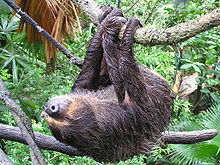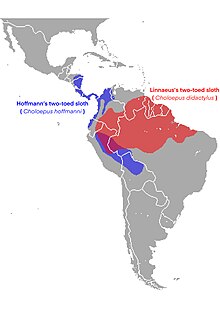Two-toed sloth
| Two-toed sloths[1] | |
|---|---|

| |
| Hoffmann's two-toed sloth (Choloepus hoffmanni) | |
| Scientific classification | |
| Domain: | Eukaryota |
| Kingdom: | Animalia |
| Phylum: | Chordata |
| Class: | Mammalia |
| Order: | Pilosa |
| Superfamily: | Mylodontoidea
|
| Family: | Choloepodidae Gray, 1871[2] |
| Genus: | Choloepus Illiger, 1811[1] |
| Type species | |
Linnaeus , 1758
| |
| Species | |
| |

| |
Choloepus is a
Extant species
| Common name | Scientific name and subspecies | Range | Size and ecology | IUCN status and estimated population |
|---|---|---|---|---|
| Linnaeus's two-toed sloth | Choloepus didactylus (Linnaeus, 1758) |
Northern South America, found in Venezuela, the Guyanas, Colombia, Ecuador, Peru, and Brazil north of the Amazon River
|
Size: Habitat: Diet: |
LC
|
| Hoffmann's two-toed sloth | Choloepus hoffmanni Peters, 1858 Five subspecies
|
Central America and northwestern South America
|
Size: Habitat: Diet: |
LC
|
Evolution
A study of retrovirus and mitochondrial DNA suggests that C. didactylus and C. hoffmani diverged 6 to 7 million years ago.[7] Furthermore, based on cytochrome c oxidase subunit I sequences, a similar divergence date (c. 7 million years ago) between the two populations of C. hofmanni separated by the Andes has been reported.[8] Their ancestors evolved with marine vertebrae, the three toed-sloth and the manatee are the only other mammals with similar vertebrae.[9]
Relation to the three-toed sloth
Both types of sloth tend to occupy the same forests; in most areas, a particular species of the somewhat smaller and generally slower-moving
Much of the morphological evidence to support the hypothesis of diphyly has been based on the structure of the inner ear.[13] Most morphological studies have concluded that convergent evolution is the mechanism that resulted in today's two genera of tree sloths. This means that the extant genera evolved analogous traits, such as locomotion methods, size, habitat, and many other traits independently from one another as opposed to from their last common ancestor. This makes tree sloths “one of the most striking examples of convergent evolution known among mammals”.[12]
Recently obtained molecular data from collagen
The following sloth family phylogenetic tree is based on collagen and mitochondrial DNA sequence data (see Fig. 4 of Presslee et al., 2019).[3]
Folivora
|
| |||||||||||||||||||||||||||||||||||||||||||||||||||
Characteristics

The name "two-toed sloth" was intended to describe an anatomical difference between the genera Choloepus and Bradypus, but does so in a potentially misleading way. Members of Choloepus have two digits on their forelimbs (the thoracic limbs) and three digits on their hindlimbs (the pelvic limbs), while members of Bradypus have three digits on all limbs. Although the term "two-fingered" sloth is arguably less misleading, the shorter "two-toed" is much more widely used.[note 1]
Members of Choloepus are larger than three-toed sloths, having a body length of 58 to 70 centimetres (23 to 28 in), and weighing 4 to 8 kilograms (8.8 to 17.6 lb). Other distinguishing features include a more prominent snout, longer fur, and the absence of a tail.[14]
Behaviour
Two-toed sloths spend most of their lives hanging upside down from trees. They cannot walk, so they pull hand-over-hand to move around, which is at an extremely slow rate. Almost all of their movement comes from this suspended upside down position, at a higher degree than even three-toed sloths. As a result, they tend to gravitate towards less vertical portions of trees.[15][16] Being predominantly nocturnal, their fur, which grows greenish algae to blend in, is their main source of protection.[17] Their body temperatures depend at least partially on the ambient temperature; they cannot shiver to keep warm, as other mammals do, because of their unusually low metabolic rates and reduced musculature.[14] Two-toed sloths also differ from three-toed sloths in their climbing behavior, preferring to descend head first.
Lifecycle

Two-toed sloths have a gestation period of six months to a year, depending on the species. Their ovarian cycle lasts around 31 to 33 days, independently of the seasons but dependent on the species.[18] The mother gives birth to a single young, while hanging upside down. The young are born with claws, and are weaned after about a month, although they will remain with the mother for several more months, and do not reach sexual maturity until the age of three years, in the case of females, or four to five years, in the case of males.[16] During natal dispersion, two-toed sloths prefer tropical forests over other types of habitat, often using riparian forest buffers to disperse. Although they also occupy shade-grown cacao plantations, they avoid open pastures.[19]
Feeding
They eat primarily
Dentition and skeleton
Two-toed sloths have a reduced, ever growing
Two-toed sloths are unusual among mammals in possessing as few as five
Musculature
Two-toed sloths generally have similar musculature to that of other mammals. This includes their zygomaticus muscles, their superficial masseter, their deep masseter, and their medial and lateral pterygoids. Additionally, a specific section of their anterior temporalis is arranged vertically, to allow them to sharpen their caniniform teeth.[26] They tend to have stronger flexor muscles in their fore- and hindlimbs, as well as their shoulders.[15]
Notes
- quadrupeds, whether their forelimb digits should be described as fingers is debatable.
References
- ^ OCLC 62265494.
- ^ Anderson, S. (1997). "Mammals of Bolivia, Taxonomy and Distribution". Bulletin of AMNH (231): 168.
- ^ (PDF) from the original on 12 September 2020. Retrieved 18 September 2020.
- ^ PMID 31178321.
- ^ "Sloth-World.org". Archived from the original on 2 February 2009.
- ^ Myers, Phil (2001). "Family Megalonychidae: two-toed sloths". Animal Diversity Web. University of Michigan. Archived from the original on 11 March 2017. Retrieved 11 March 2017.
- PMID 26878870.
- .
- S2CID 4369283.
- PMID 8552600.
- ISBN 978-0-8493-2001-9.
- ^ .
- PMID 25319928.
- ^ ISBN 0-87196-871-1.
- ^ S2CID 52050040.
- ^ PMID 10657054.
- ^ "sloth." Encyclopædia Britannica.
- PMID 23743067.
- ISSN 1365-2664.
- ^ Myers, Phil (2001). "Family Megalonychidae: two-toed sloths". Animal Diversity Web. University of Michigan. Retrieved 14 September 2009.
- ^ Nowak, Ronald M. Walkers (1999) Mammals of the World. Sixth Edition. Vol. 1. Baltimore and London: The Johns Hopkins University Press. pp. 149–150. Print.
- S2CID 92499258.
- ISSN 1424-2818.
- ISBN 978-1-4614-7161-5
- ^ Sloth Standards. nationalzoo.si.edu (May 27, 2005)
- ^ S2CID 36168956.
- ^ "Sticking Their Necks out for Evolution: Why Sloths and Manatees Have Unusually Long (or Short) Necks". May 6th 2011. Science Daily. Retrieved 25 July 2013.
- PMID 10327647. Archived from the original(PDF) on 10 November 2004.
- Linnaeus (1758): Systema naturae perregna tria naturae, secundum classes, ordines, genera, species cum characteribus, differentiis, syonymis, locis. Laurentii : Salvi, 824 pp.


